Students get through the TN Board 11th Bio Zoology Important Questions Chapter 3 Tissue Level of Organisation which is useful for their exam preparation.
TN State Board 11th Bio Zoology Important Questions Chapter 3 Tissue Level of Organisation
Answer the following.
Question 1.
Define tissues and write their types.
Answer:
Groups of cells that are similar in structure and perform common or related functions are called ‘tissues’.
Classification of Animal Tissues: Epithelial, Connective, Muscular, Neural.
Question 2.
Why tissues are called living fabrics.
Answer:
Tissues are organized in specific proportions and patterns to form organs like lungs, heart, stomach, kidneys, ovaries, testes etc., hence the tissues are called the ‘living fabrics’.
Question 3.
Classify animal tissues.
Answer:
Animal tissues are classified according to the size, shape and function of the cells. There are four primaries (basic) tissue types that interweave to form the ‘fabric’ of the body. They are the epithelial tissue (covering), the connective tissue (support), the muscle tissue (movement) and the nervous tissue (control).
![]()
Question 4.
Write about the special features of simple epithelium, its location, and its different types. Draw suitable diagrams also.
Answer:
- Simple epithelium is composed of a single layer of cells. They are found in the organs of absorption, secretion and filtration. Simple epithelial tissue is further classified into squamous epithelium, cuboidal epithelium, columnar epithelium, ciliated epithelium and pseudostratified epithelium. The squamous epithelium is made of a single thin layer of flattened cells with irregular boundaries. They are found in the kidney glomeruli, air sacs of lungs, lining of heart, blood vessels and lymphatic vessels and are involved in functions like forming a diffusion boundary and filtration in sites where protection is not important.
- The cuboidal epithelium is made of a single layer of cube-like cells. This tissue is commonly found in the kidney tubules, ducts and secretory portions of small glands and the surface of the ovary. Its main functions are secretion and absorption.
- The columnar epithelium is composed of a single layer of tall cells with round to oval nuclei at the base. It lines the digestive tract from the stomach to the rectum.
- The functions of this epithelium include absorption, secretion of mucus, enzymes and other substances.
- This ciliated type propels mucus by ciliary actions and it lines the small bronchioles, fallopian tubes and uterus. Non-ciliated type lines most of the digestive tract, gall bladder and secretory ducts of glands.
- Pseudo-stratified epithelial cells are columnar but unequal in size. Although the epithelium is single-layered yet it appears to be multi-layered because the nuclei lie at different levels in different cells. Hence, it is also called pseudostratified epithelium and its functions are protection, secretion and absorption. Ciliated forms line the trachea and the upper respiratory tract. The non-ciliated forms line the epididymis, large ducts of glands and tracts of the male urethra.
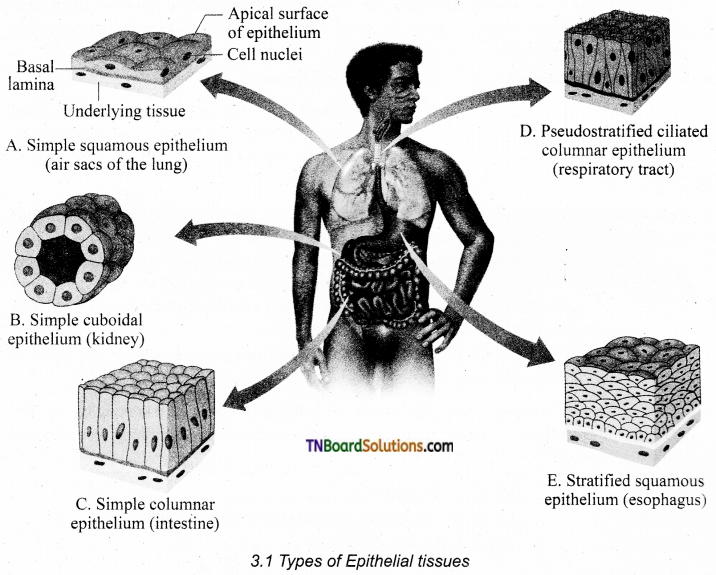
![]()
Question 5.
Write about the modified columnar epithelium.
Answer:
Some of the cuboidal or columnar cells get specialized for secretion and are called the glandular epithelium. They are mainly of two types: unicellular, consisting of isolated glandular cells (goblet cells of the alimentary canal), and multicellular, consisting of a cluster of cells (salivary gland). On the basis of the mode of pouring of their secretions, glands are divided into two categories namely exocrine and endocrine glands. Exocrine glands secrete mucus, saliva, earwax, oil, milk, digestive enzymes and other cell products. These products are released through ducts or tubes. In contrast, endocrine glands do not have ducts. Their secretions called hormones are secreted directly into the fluid bathing the gland. The exocrine glands are classified as unicellular and multicellular glands. The multicellular glands are further classified based on the structure as simple and compound glands, based on their secretory units as tubular, alveolar, (Acinus) and tubuloalveolar.
Question 6.
What are the types of exocrine glands? Differentiate the both.
Answer:
- The exocrine glands are classified as unicellular and multicellular glands.
- Unicellular, consisting of isolated glandular cells (goblet cells of the alimentary canal), and multicellular, consisting of a cluster of cells (salivary gland).
Question 7.
Name the exocrine glands based on their mode of secretions.
Answer:
Based on the mode of secretion exocrine glands are classified as merocrine, holocrine and apocrine.
Question 8.
What is the main function of compound epithelium and what are its types.
Answer:
- The compound epithelium is made of more than one layer (multi-layered) of cells and thus has a limited role in secretion and absorption.
- Their main function is to provide protection against chemical and mechanical stresses.
There are four types of compound epithelium namely, stratified squamous epithelium, cuboidal epithelium, columnar epithelium and transitional epithelium.
Question 9.
Write the location of compound epithelium.
Answer:
The compound epithelium covers the dry surface of the skin, the moist surface of the buccal cavity, pharynx, the inner lining of ducts of salivary glands and of pancreatic ducts.
![]()
Question 10.
Write about the different types of compound epithelium.
Answer:
There are four types of compound epithelium namely, stratified squamous epithelium, cuboidal epithelium, columnar epithelium and transitional epithelium.
Stratified squamous epithelium is of two types called keratinized type which forms the dry epidermis of the skin and the non keratinized type forms the moist lining of the oesophagus, mouth, conjunctiva of the eyes and vagina. Stratified cuboidal epithelium mostly found in the ducts of sweat glands and mammary glands. The stratified columnar epithelium has limited distribution in the body, found around the lumen of the pharynx, male urethra and lining of some glandular ducts.
Transitional Epithelium is found lining the ureters, urinary bladder and part of the urethra. This epithelium allows stretching and is protective in function.
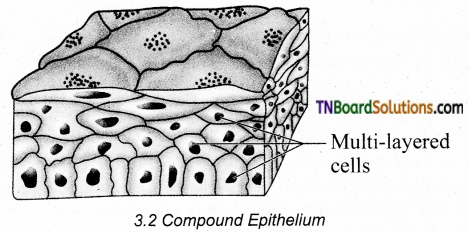
Question 11.
What is cell junction? What are its different types?
Answer:
All cells of the epithelium are held together with little intercellular material. In most animal tissues, specialized junctions provide both structural and functional links between their individual cells. Three types of cell junctions are found in the epithelium and other tissues. These are called tight, adhering and gap junctions.
Question 12.
Name the different types of cell junction and their functions.
Answer:
Tight junctions help to stop substances from leaking across a tissue. Adhering junctions perform cementing to keep neighbouring cells together. Gap junctions facilitate the cells to communicate with each other by connecting the cytoplasm of adjoining cells, for rapid transfer of ions, small molecules and sometimes big molecules.
Question 13.
Name the three types of fibres found in the connective tissues matrix.
Answer:
The ‘Fibres’ of connective tissue provide support. Three types of fibres are found in the connective tissue matrix. They are collagen, elastic and reticular fibres.
![]()
Question 14.
Name the two broad types of connective tissues.
Answer:
Connective tissue is of two types namely, Loose connective tissues (Areolar, Adipose and Reticular) and Dense connective tissues (dense regular, dense irregular and elastic).
Question 15.
Write an account on different varieties of loose connective tissue.
Answer:
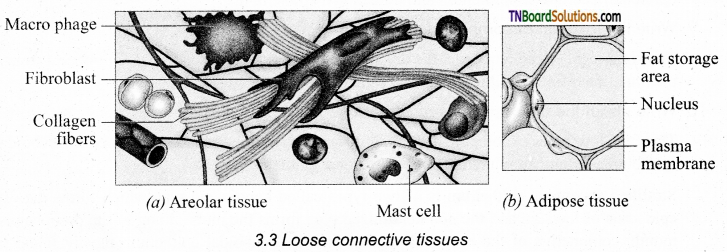
- In this tissue, the cells and fibres are loosely arranged in semi-fluid ground substances.
- It contains fibroblasts, macrophages, and mast cells.
- The Areolar connective tissue beneath the skin acts as a support framework for epithelium and acts as a reservoir of water and salts for the surrounding body tissues, hence aptly called tissue fluid.
- Adipose tissue is similar to areolar tissue in structure and function and located beneath the skin. Adipocytes commonly called adipose or fat cells predominate and account for 90% of this tissue mass.
- While fasting, these cells maintain our life by producing and supplying energy as fuel. Adipose tissues are also found in subcutaneous tissue, surrounding the kidneys, eyeball, heart, etc. Adipose tissue is called ‘white fat’ or white adipose tissue. The adipose tissue which contains abundant mitochondria is called ‘Brown fat’ or Brown adipose tissue. White fat stores nutrients whereas brown fat is used to heat the bloodstream to warm the body. Brown fat produces heat by non-shivering thermogenesis in neonates.
Question 16.
Write the differences between dense regular connective tissues and dense irregular connective tissues.
Answer:
Dense regular connective tissues primarily contain collagen fibres in rows between many parallel bundles of tissues and a few elastic fibres. The major cell type is a fibroblast. It attaches muscles and bones and withstands great tensile stress when pulling force is applied in one direction. This connective tissue is present in tendons, that attach skeletal muscles to bones and ligaments attach one bone to another.
Dense irregular connective tissues have bundles of thick collagen fibres and fibroblasts which are arranged irregularly. The major cell type is the fibroblast. It is able to withstand tension exerted in many directions and provides structural strength. Some elastic fibres are also present. It is found in the skin as the leathery dermis and forms fibrous capsules of organs such as kidneys, bones cartilages, muscles, nerves and joints. Elastic connective tissue contains a high proportion of elastic fibres. It allows recoil of tissues following stretching. It maintains the pulsatile flow of blood through the arteries and the passive recoil of the lungs following inspiration. It is found in the walls of large arteries; ligaments associated with the vertebral column and within the walls of the bronchial tubes.
![]()
Question 17.
Name the divisions of specialised connective tissue.
Answer:
Specialised connective tissues are classified as cartilage, bones and blood,
Question 18.
Give an account of different varieties of specialised connective tissue.
Answer:
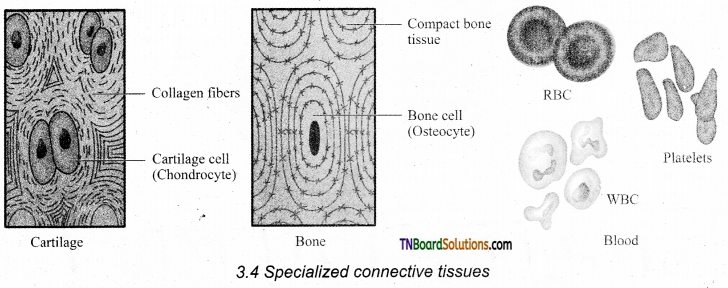
Specialised connective tissues are classified as cartilage, bones and blood. Cartilage is solid and pliable and resists compression. Cells of this tissue (chondrocytes) are enclosed in small cavities within the matrix secreted by them. Most of the cartilages in vertebrate embryos are replaced by bones in adults. Cartilage is present in the tip of the nose, outer ear joints, ear pinna, between adjacent bones of the vertebral column, limbs and hands in adults.
Bones have a hard and non-pliable ground substance rich in calcium salts and collagen fibres which gives strength to the bones. It is the main tissue that provides a structural frame to the body. Bones support and protect softer tissues and organs. The bone cells (osteocytes) are present in the spaces called lacunae. Limb bones, such as the long bones of the legs, serve weight-bearing functions. They also interact with skeletal muscles attached to them to bring about movements. The bone marrow in some bones is the site of the production of blood cells.
Blood is the fluid connective tissue containing plasma, red blood cells (RBC), white blood cells (WBC) and platelets. It functions as the transport medium for the cardiovascular system, carrying nutrients, wastes, respiratory gases throughout the body.
![]()
Question 19.
Mention the places where cartilage bones are located in the human body.
Answer:
Cartilage is present in the tip of the nose, outer ear joints, ear pinna, between adjacent bones of the vertebral column, limbs and hands in adults.
Question 20.
What is muscle tissue? What is its main function?
Answer:
Each muscle is made of many long, cylindrical fibres arranged in parallel arrays. These fibres are composed of numerous fine fibrils, called myofibrils. Muscle fibres contract (shorten) in response to stimulation, then relax (lengthen) and return to their uncontracted state in a coordinated fashion. In general, muscles play an active role in all the movements of the body.
Question 21.
Write an account on different types of muscles with a neat diagram, (or)
Write a short note of the following:- (i) Skeletal muscle, (ii) Smooth muscle, (iii) Cardiac muscle.
Answer:
Muscles are of three types, skeletal, smooth and cardiac. They are –
- Skeletal muscle,
- Smooth muscle,
- Cardiac muscle.
(i) Skeletal muscle:
Skeletal muscle tissue is closely attached to skeletal bones. In a typical muscle such as the biceps, the striated (striped) skeletal muscle fibres are bundled together in a parallel fashion. A sheath of tough connective tissue encloses several bundles of muscle fibres.
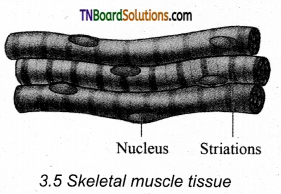
(ii) Smooth muscle:
The smooth muscle fibres taper at both ends (fusiform) and do not show striations. Cell junctions hold them together and they are bundled together in a connective tissue sheath. The walls of internal organs such as the blood vessels, stomach and intestine contain this type of muscle tissue. Smooth muscles are “involuntary’ as their functions cannot be directly controlled. Unlike smooth muscles, skeletal muscles can not be controlled by merely thinking.
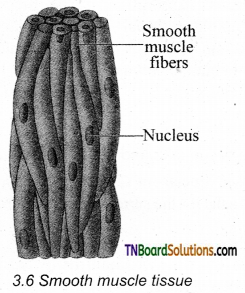
(iii) Cardiac muscle:
Cardiac muscle tissue is contractile tissue present only in the heart. Cell junctions fuse the plasma membranes of cardiac muscle cells and make them stick together. Communication junctions (intercalated discs) at some fusion points allow the cells to contract as a unit, i.e., when one cell receives a signal to contract, its neighbours are also stimulated to contract.
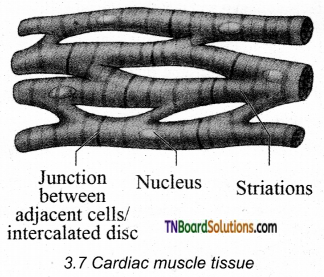
![]()
Question 22.
Differentiate simple epithelium from squamous epithelium.
Answer:
| Simple Epithelium | Squamous epithelium |
| Simple epithelium is composed of a single layer of cells. | The squamous epithelium is made of a single thin layer of flattened cells with irregular boundaries. |
| They are found in the organs of absorption, secretion and filtration. Simple epithelial tissue is further classified into squamous epithelium, cuboidal epithelium, columnar epithelium, ciliated epithelium and pseudostratified epithelium. | They are found in the kidney glomeruli, air sacs of lungs, lining of heart, blood vessels and lymphatic vessels and are involved in functions like forming a diffusion boundary and filtration in sites where protection is not important. |
Question 23.
Why Areolar connective tissue is called tissue fluids.
Answer:
The Areolar connective tissue beneath the skin acts as a support framework for epithelium and acts as a reservoir of water and salts for the surrounding body tissues, hence aptly called tissue fluid.
Question 24.
What is a biopsy?
Answer:
A biopsy is an examination of tissue or liquid removed from a living body to discover the presence, cause or extent of a disease.
Question 25.
What is an autopsy?
Answer:
An autopsy is a post-mortem (dissection of a dead body) examination to discover the cause of death or the extent of disease.
![]()
Question 26.
Write about the heritable connective tissue disorders?
Answer:
Ehler’s -Danlos syndrome: Defect in the synthesis of collagen in the joints, heart valves, organ walls and arterial walls.
Stickler syndrome: Affects collagen and results in facial abnormalities.
Rhabdomyosarcoma: Life-threatening soft tissue tumour of head, neck and urinogenital tract.
Question 27.
What are autoimmune connective tissue disorders? Write its symptoms.
Answer:
Rheumatoid arthritis: The immune cells attack and inflame the membranes around the joints.
It can also affect the heart, lungs and eyes.
Sjogren’s syndrome: Progressive inability to secrete saliva and tears.
Question 28.
Name the diseases of the nervous system and mention their symptoms.
Answer:
Parkinson’s disease: A degenerative disorder of the nervous system that affects movement, often including tremors.
Alzheimer’s disease: It is a chronic neurodegenerative disease that includes the symptoms of difficulty in remembering recent events, problems with language, disorientation and mood swings.
Question 29.
Mention the names of disorders of epithelial tissue.
Answer:
Eczema, Psoriasis, Epithelial Carcinoma and severe asthma.
Choose the correct answer.
1. Group of cells that are similar in structure and fûnction are called:
(a) Organ
(b) Organ system
(c) Tissues
(d) Germ layers
Answer:
(c) Tissues
![]()
2. ………… is a contractile tissue present only in the heart.
(a) Kidney
(b) digestive tract
(c) Heart
(d) Brain
Answer:
(c) Heart
3. ………. is closely attached to skeletal bones.
(a) Smooth muscle
(b) cardiac muscle
(c) Muscle fibers
(d) Striped muscle
Answer:
(d) Striped muscle
4. …………. is a fluid cãnnective tissue.
(a) Lymph
(b) Blood
(c) Mucus
(d) Saliva
Answer:
(b) Blood
5. The study of tissues is known as:
(a) Histology
(b) Anatomy
(c) Physiology
(d) Genetics
Answer:
(a) Histology
6. …………… is the type of modified columnar epithelium which secretes the protective lubricating mucus.
(a) Sebaceous gland
(b) Oil glands
(c) Mast cells
(d) Goblet cells
Answer:
(d) Goblet cells
![]()
7. The secretions of endocrine glands ari called:
(a) Enzymes
(b) Hormones
(c) Granules
(d) Cell fragments
Answer:
(b) Hormones
8. Dry epidermis of the skin is lined with:
(a) Keratinized type of stratified squamous epithelium
(b) Stratified cuboidal epithelium
(c) Non keratinized type of stratified squamous epithelium
(d) Transitional epithelium
Answer:
(a) Keratinized type of stratified squamous epithelium
9. ……….. helps to stop substances from leaking across a tissue.
(a) Gap junction
(b) Tissue junction
(c) Tight junction
(d) Adhering junction
Answer:
(c) Tight junction
10. The adipose tišsue which contains abundant mitochondria is called:
(a) white fat
(b) fat cells
(c) brown fat
(d) white adipose tissue.
Answer:
(c) brown fat
11. The skeletal muscles and bones are attached by:
(a) fibroblast
(b) stroma
(c) tendons
(d) cartilages
Answer:
(c) tendons
12. The cartilage cells are called:
(a) Chondrocytes
(b) Osteocytes
(e) Melanocytes
(d) Lymphocytes
Answer:
(a) Chondrocytes
![]()
13. The …………. of bones is the site of production of blood cells.
(a) Osteocytes
(b) Bone marrow
(c) Collagen fibres
(d) Chondrocytes
Answer:
(b) Bone marrow
14. These are the fundamental units of neural tissues:
(a) Cartilages
(b) Nephrons
(c) Tendons
(d) Neurons
Answer:
(d) Neurons